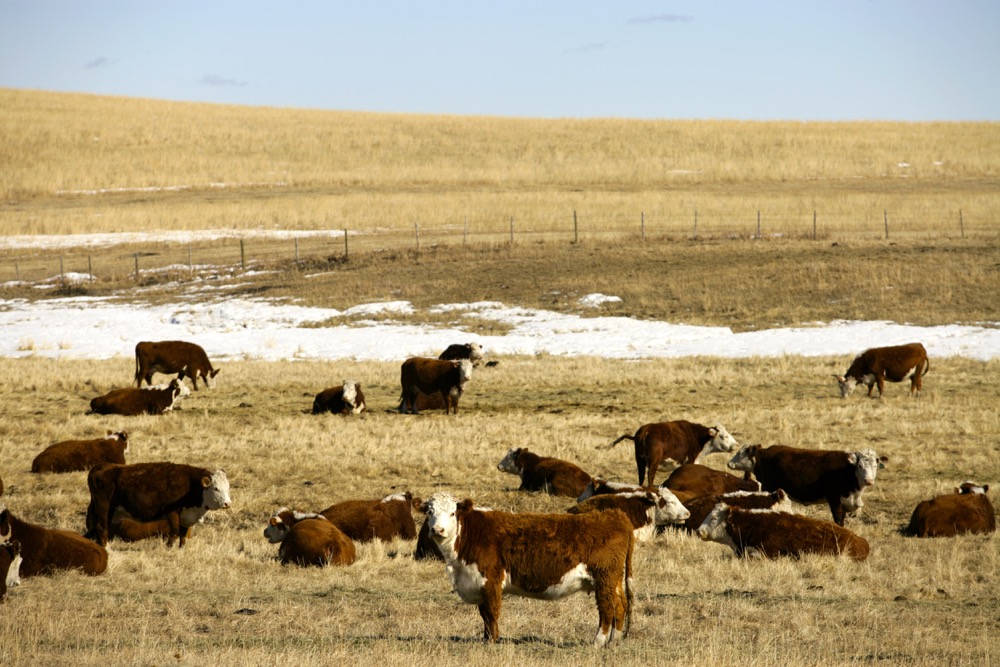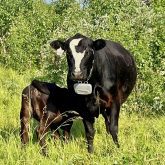Beef cattle on the Canadian Prairies are subject to considerable environmental stress during winter. Starting with the early days of ranching and arrival of U.S. cattle onto the eastern slopes of the Rockies through the mid-1800s, survival of the beef cow meant adaptation to prolonged cold temperatures. Cold and the groundless belief that cattle could survive on low energy forage salvaged from beneath snow banks ultimately brought many of the “great” ranches to their knees. Up to half the herds died through tough winters and reproductive rates were abysmal. Though most beef breeds adapted to our climate, survival of the modern cow through blizzards and extreme cold without adequate feed remains tentative. Animals in good body condition with access to shelter or windbreaks can withstand acute and prolonged cold stress. Paying attention to lower critical threshold temperature (LCT) and the digestible energy of feedstuffs prevents one of the pregnant beef cow’s greatest enemies: abomasal impaction.
Read Also

Body condition, nutrition and vaccination for brood cows
One of the remarkable events of the past century related to ranching has been the genetic evolution of brood cows….
Impaction of the abomasum develops in pregnant beef cows during cold winter months when cattle have decreased water intake and are fed poor-quality roughage. Impaction with sand can occur if cattle are fed hay or silage on sandy soils, or root crops that are sandy or dirty.
Without wind, the low critical threshold (LCT) temperature for most beef cattle on the Prairies is -20 C. During cold, windy or wet weather when temperatures fall below -20 C, heat production of the animal must increase immediately to prevent a drop in body temperature. This means eating more or eating forage/grain with higher energy content. Rain, melting snow, or wind significantly increases environmental coldness For example, a -5 C temperature with 40 km/hour winds is equivalent to -20 C with no wind.
Weight, condition and energy intake change the LCT. Dairy cows and feedlot cattle on high grain rations have a very low LCT (-30 C to -45 C) because of their high feed intake and metabolic rate. The LCT for pregnant beef cows, dry dairy cows and growing calves, in good body condition, is between -10 C and -25 C. Young calves, from birth to three weeks of age, have a LCT of +13 C. Dairy calves from three weeks old to weaning have a LCT of +1 C.
Animals in good body condition are better able to tolerate extreme cold. For example, thin cows with a BCS of 1-2 have a LCT of -17 C while cows in good condition with a BCS of 3 have a LCT of close to -25 C. This is another good reason for feeding thin cows separately from the rest of the herd. Providing a wind break and/or shelter, ensuring cattle have good body fat stores and feeding additional energy (i.e. grain) will help all cattle survive acute cold stress with a minimum of suffering and long-term effects.
The major effect of cold on nutrient requirements of cows is increased need for energy. During periods of extreme cold, the pregnant cow is under considerable stress. She eats to satisfy energy needs. While access to shelter and water play a role, the critical factor of enduring winter extremes is high-quality forage and grain. Consumption of excess roughage low in digestible protein and energy leads to impaction of the abomasum or fourth stomach. Abomasal impaction develops slowly. By the time clinical signs are noticed, cows are often beyond help. Outbreaks may affect 15 per cent of pregnant cattle on individual farms.
Cows with abomasal impaction stop eating, pass little or no feces, lose weight, become dehydrated and appear weak. Often, the abdomen of affected cattle when observed from behind appears full, but the distension caused by either the accumulation of dry contents or fluid in the rumen (main stomach) is deceptive. Typically, animals die over a period of three to six days. Sudden death due to rupture of the stomach wall and overwhelming infection is not uncommon. Moderate to severe dehydration develops, because fluids do not move beyond the abomasum into the small intestine where they are normally absorbed.
A general rule: for every 10 degrees below -20 C at midday, beef cows require an additional four to six Mcals of digestible energy (DE). Barley contains 1.5 Mcals DE per pound, so adding three to four pounds of barley to the cow’s ration during cold stress would meet the additional needs.
When the temperature drops and remains below the thermoneutral, or comfort, zone (15 C to 20 C), other adaptive changes occur. Hair coat becomes thicker and longer. The metabolic rate increases. Feed intake can increase by up to 30 per cent. Digestibility of forages is reduced in cold weather (cattle are getting less energy from a given amount of feed). Energy requirements increase approximately 10 per cent for every 10 degree drop in effective temperature below the comfort zone. In meeting increased energy requirements cows in good condition can increase daily consumption of good-quality hay by about 10 pounds maximum. Beyond this, additional energy must be supplied as grain.
Clinical diagnosis of dietary abomasal impaction is based on the nutritional history, clinical evidence of impaction, and laboratory results. Individual cases of abomasal impaction in late pregnancy sometimes appear as a complication of hardware disease.
The challenge is to recognize the cases of dietary abomasal impaction that will respond to treatment and those that will not. Animals may be salvageable; many are not. Treatment is seldom successful and requires intravenous fluids, laxatives and often abdominal surgery. Induction of calving may be warranted if parturition is within two weeks.
The nutrient requirements of beef cattle (see Nutritional Requirements of Beef Cattle) are guidelines for use under average conditions. Higher nutrient levels than those indicated may be necessary, particularly during periods of severe cold stress. Adequate fresh drinking water should be supplied at all times; the practice of forcing wintering cows to obtain their water requirements by eating snow while on low-quality roughage is hazardous.

















